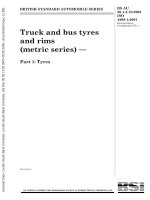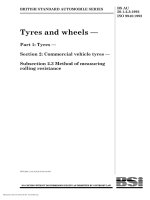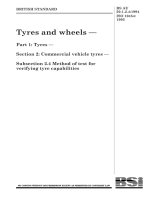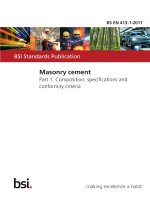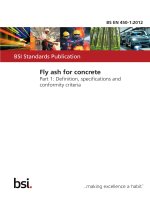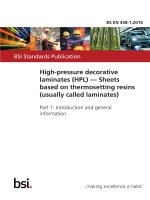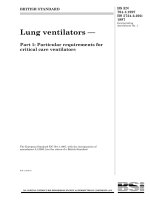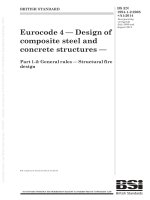Bsi bs en 61000 1 2 2016
Bạn đang xem bản rút gọn của tài liệu. Xem và tải ngay bản đầy đủ của tài liệu tại đây (3.66 MB, 80 trang )
BS EN 61000-1-2:2016
BSI Standards Publication
Electromagnetic
compatibility (EMC)
Part 1-2: General — Methodology for the
achievement of functional safety of electrical
and electronic systems including equipment
with regard to electromagnetic phenomena
BRITISH STANDARD
BS EN 61000-1-2:2016
National foreword
This British Standard is the UK implementation of EN 61000-1-2:2016. It is
identical to IEC 61000-1-2:2016. It supersedes DD IEC/TS 61000-1-2:2008
which will be withdrawn on 18 May 2019.
The UK participation in its preparation was entrusted to Technical
Committee GEL/210, EMC - Policy committee.
A list of organizations represented on this committee can be obtained on
request to its secretary.
This publication does not purport to include all the necessary provisions of
a contract. Users are responsible for its correct application.
© The British Standards Institution 2016.
Published by BSI Standards Limited 2016
ISBN 978 0 580 86797 2
ICS 33.100.99
Compliance with a British Standard cannot confer immunity from
legal obligations.
This British Standard was published under the authority of the
Standards Policy and Strategy Committee on 31 October 2016.
Amendments/corrigenda issued since publication
Date
Text affected
BS EN 61000-1-2:2016
EUROPEAN STANDARD
EN 61000-1-2
NORME EUROPÉENNE
EUROPÄISCHE NORM
September 2016
ICS 33.100.99
English Version
Electromagnetic compatibility (EMC) - Part 1-2: General Methodology for the achievement of functional safety of electrical
and electronic systems including equipment with regard to
electromagnetic phenomena
(IEC 61000-1-2:2016)
Compatibilité électromagnétique (CEM) - Partie 1-2:
Généralités - Méthodologie pour la réalisation de la sécurité
fonctionnelle des systèmes électriques et électroniques, y
compris les équipements, du point de vue des phénomènes
électromagnétiques
(IEC 61000-1-2:2016)
Elektromagnetische Verträglichkeit (EMV) - Teil 1-2:
Allgemeines - Verfahren zum Erreichen der funktionalen
Sicherheit von elektrischen und elektronischen Systemen
einschließlich Geräten und Einrichtungen im Hinblick auf
elektromagnetische Phänomene
(IEC 61000-1-2:2016)
This European Standard was approved by CENELEC on 2016-05-18. CENELEC members are bound to comply with the CEN/CENELEC
Internal Regulations which stipulate the conditions for giving this European Standard the status of a national standard without any alteration.
Up-to-date lists and bibliographical references concerning such national standards may be obtained on application to the CEN-CENELEC
Management Centre or to any CENELEC member.
This European Standard exists in three official versions (English, French, German). A version in any other language made by translation
under the responsibility of a CENELEC member into its own language and notified to the CEN-CENELEC Management Centre has the
same status as the official versions.
CENELEC members are the national electrotechnical committees of Austria, Belgium, Bulgaria, Croatia, Cyprus, the Czech Republic,
Denmark, Estonia, Finland, Former Yugoslav Republic of Macedonia, France, Germany, Greece, Hungary, Iceland, Ireland, Italy, Latvia,
Lithuania, Luxembourg, Malta, the Netherlands, Norway, Poland, Portugal, Romania, Slovakia, Slovenia, Spain, Sweden, Switzerland,
Turkey and the United Kingdom.
European Committee for Electrotechnical Standardization
Comité Européen de Normalisation Electrotechnique
Europäisches Komitee für Elektrotechnische Normung
CEN-CENELEC Management Centre: Avenue Marnix 17, B-1000 Brussels
© 2016 CENELEC All rights of exploitation in any form and by any means reserved worldwide for CENELEC Members.
Ref. No. EN 61000-1-2:2016 E
BS EN 61000-1-2:2016
EN 61000-1-2:2016
European foreword
The text of document 77/513/FDIS, future edition 1 of IEC 61000-1-2, prepared by IEC/TC 77
“Electromagnetic compatibility" was submitted to the IEC-CENELEC parallel vote and approved by
CENELEC as EN 61000-1-2:2016.
The following dates are fixed:
•
latest date by which the document has to be
implemented at national level by
publication of an identical national
standard or by endorsement
(dop)
2017-03-30
•
latest date by which the national
standards conflicting with the
document have to be withdrawn
(dow)
2019-09-30
Attention is drawn to the possibility that some of the elements of this document may be the subject of
patent rights. CENELEC [and/or CEN] shall not be held responsible for identifying any or all such
patent rights.
Endorsement notice
The text of the International Standard IEC 61000-1-2:2016 was approved by CENELEC as a
European Standard without any modification.
In the official version, for Bibliography, the following notes have to be added for the standards indicated:
2
IEC 61000-2 (series)
NOTE
Harmonized as EN 61000-2 (series).
IEC 61000-2-3
NOTE
Harmonized as EN 61000-2-3.
IEC 61000-2-4
NOTE
Harmonized as EN 61000-2-4.
IEC 61000-4-2
NOTE
Harmonized as EN 61000-4-2.
IEC 61000-4-3
NOTE
Harmonized as EN 61000-4-3.
IEC 61000-4-4
NOTE
Harmonized as EN 61000-4-4.
IEC 61000-4-5
NOTE
Harmonized as EN 61000-4-5.
IEC 61000-4-6
NOTE
Harmonized as EN 61000-4-6.
IEC 61000-4-8
NOTE
Harmonized as EN 61000-4-8.
IEC 61000-4-9
NOTE
Harmonized as EN 61000-4-9.
IEC 61000-4-10
NOTE
Harmonized as EN 61000-4-10.
IEC 61000-4-11
NOTE
Harmonized as EN 61000-4-11.
IEC 61000-4-12
NOTE
Harmonized as EN 61000-4-12.
IEC 61000-4-13
NOTE
Harmonized as EN 61000-4-13.
BS EN 61000-1-2:2016
EN 61000-1-2:2016
IEC 61000-4-16
NOTE
Harmonized as EN 61000-4-16.
IEC 61000-4-18
NOTE
Harmonized as EN 61000-4-18.
IEC 61000-4-19
NOTE
Harmonized as EN 61000-4-19.
IEC 61000-4-20
NOTE
Harmonized as EN 61000-4-20.
IEC 61000-4-21
NOTE
Harmonized as EN 61000-4-21.
IEC 61000-4-23
NOTE
Harmonized as EN 61000-4-23.
IEC 61000-4-24
NOTE
Harmonized as EN 61000-4-24.
IEC 61000-4-25
NOTE
Harmonized as EN 61000-4-25.
IEC 61000-4-27
NOTE
Harmonized as EN 61000-4-27.
IEC 61000-4-28
NOTE
Harmonized as EN 61000-4-28.
IEC 61000-4-29
NOTE
Harmonized as EN 61000-4-29.
IEC 61000-4-34
NOTE
Harmonized as EN 61000-4-34.
IEC 61000-6-1
NOTE
Harmonized as EN 61000-6-1.
IEC 61000-6-2
NOTE
Harmonized as EN 61000-6-2.
IEC 61000-6-3
NOTE
Harmonized as EN 61000-6-3.
IEC 61000-6-4
NOTE
Harmonized as EN 61000-6-4.
IEC 61508-1:2010
NOTE
Harmonized as EN 61508-1:2010.
IEC 61508-2
NOTE
Harmonized as EN 61508-2.
IEC 61508-3
NOTE
Harmonized as EN 61508-3.
IEC 61508-4:2010
NOTE
Harmonized as EN 61508-4:2010.
IEC 61508-5
NOTE
Harmonized as EN 61508-5.
IEC 61508-6
NOTE
Harmonized as EN 61508-6.
IEC 61508-7
NOTE
Harmonized as EN 61508-7.
IEC 62305-1:2010
NOTE
Harmonized as EN 62305-1:2010.
IEC 62305-2:2010
NOTE
Harmonized as EN 62305-2:2010.
3
BS EN 61000-1-2:2016
EN 61000-1-2:2016
Annex ZA
(normative)
Normative references to international publications
with their corresponding European publications
The following documents, in whole or in part, are normatively referenced in this document and are
indispensable for its application. For dated references, only the edition cited applies. For undated
references, the latest edition of the referenced document (including any amendments) applies.
NOTE 1 When an International Publication has been modified by common modifications, indicated by (mod), the relevant
EN/HD applies.
NOTE 2 Up-to-date information on the latest versions of the European Standards listed in this annex is available here:
www.cenelec.eu.
Publication
IEC 60050-161
Year
-
IEC 61000-4-1
-
IEC 61000-4
IEC 61000-6-7
series
-
IEC 61508
series
IEC/TR 61000-1-6 IEC/TR 61000-2-5 -
4
Title
EN/HD
International Electrotechnical Vocabulary (IEV) -- Chapter 161: Electromagnetic
compatibility
Electromagnetic compatibility (EMC) -- Part EN 61000-4-1
4-1: Testing and measurement techniques
- Overview of IEC 61000-4 series
Electromagnetic compatibility (EMC)
Electromagnetic compatibility (EMC) - Part EN 61000-6-7
6-7: Generic standards - Immunity
requirements for equipment intended to
perform functions in a safety-related
system (functional safety) in industrial
locations
Functional safety of
EN 61508
electrical/electronic/programmable
electronic safety-related systems
Electromagnetic compatibility (EMC) - Part 1-6: General - Guide to the assessment of
measurement uncertainty
Electromagnetic compatibility (EMC) - Part 2-5: Environment - Description and
classification of electromagnetic
environments
Year
-
series
-
series
-
–2–
BS EN 61000-1-2:2016
IEC 61000-1-2:2016 © IEC 2016
CONTENTS
FOREWORD ......................................................................................................................... 5
INTRODUCTION ................................................................................................................... 7
Particular considerations for IEC 61000-1-2........................................................................... 7
1
Scope ............................................................................................................................ 8
2
Normative references..................................................................................................... 9
3
Terms, definitions and abbreviations .............................................................................. 9
3.1
Terms and definitions ............................................................................................ 9
3.2
Abbreviations ...................................................................................................... 14
4
General considerations ................................................................................................ 15
4.1
General ............................................................................................................... 15
4.2
Considerations with regard to electromagnetic phenomena .................................. 18
5
Achievement of functional safety .................................................................................. 19
5.1
5.2
5.3
5.4
General ............................................................................................................... 19
Safety lifecycle .................................................................................................... 20
Safety integrity .................................................................................................... 20
Specific steps for the achievement of functional safety with regard to
electromagnetic disturbances .............................................................................. 21
5.5
Management of EMC for functional safety ............................................................ 21
5.5.1
General ....................................................................................................... 21
5.5.2
Management of functional safety performance with respect to
electromagnetic phenomena at system level ................................................. 21
5.5.3
Management of functional safety performance with respect to
electromagnetic phenomena at element supplier level ................................... 22
6
Electromagnetic environment ....................................................................................... 23
6.1
6.2
6.3
6.4
7
EMC
General ............................................................................................................... 23
Electromagnetic environment information ............................................................. 24
Methodology to assess the electromagnetic environment ..................................... 25
Deriving test levels and methods ......................................................................... 25
aspects of the design and integration process ...................................................... 26
7.1
General ............................................................................................................... 26
7.2
EMC aspects on system level .............................................................................. 27
7.3
EMC aspects on equipment level ......................................................................... 28
8
Verification and validation of functional safety performance in respect of
electromagnetic disturbances ....................................................................................... 29
8.1
Verification and validation processes ................................................................... 29
8.2
Verification .......................................................................................................... 31
8.3
Validation ............................................................................................................ 31
8.4
Test philosophy for equipment intended for use in safety-related systems ............ 32
8.4.1
General ....................................................................................................... 32
8.4.2
Performance criterion DS for safety applications ........................................... 32
8.4.3
Application of the performance criterion DS .................................................. 32
8.4.4
Relationship to “normal” EMC standards ....................................................... 33
8.5
Test philosophy for safety-related systems .......................................................... 33
9
EMC testing with regard to functional safety ................................................................. 34
9.1
Electromagnetic test types and electromagnetic test levels with regard to
functional safety .................................................................................................. 34
BS EN 61000-1-2:2016
IEC 61000-1-2:2016 © IEC 2016
–3–
9.1.1
Considerations on testing ............................................................................. 34
9.1.2
Types of immunity tests ................................................................................ 34
9.1.3
Testing levels............................................................................................... 34
9.2
Determination of test methods with regard to functional safety ............................. 35
9.3
Considerations on test methods and test performance with regard to
systematic capability ........................................................................................... 36
9.3.1
General ....................................................................................................... 36
9.3.2
Testing period .............................................................................................. 37
9.3.3
Number of tests with different test set-ups or test samples ............................ 37
9.3.4
Variation of test settings ............................................................................... 38
9.3.5
Environmental factors .................................................................................. 38
9.4
Testing uncertainty .............................................................................................. 39
10 Documentation ............................................................................................................ 39
Annex A (informative) Selection of electromagnetic phenomena .......................................... 40
Annex B (informative) Measures and techniques for the achievement of functional
safety with regard to electromagnetic disturbances .............................................................. 43
B.1
General principles ............................................................................................... 43
B.2
Choosing design techniques and measures ......................................................... 44
B.2.1
Introduction to design techniques and measures against
electromagnetic disturbances ....................................................................... 44
B.2.2
Some further details on the design techniques and measures ....................... 53
Annex C (informative) Information concerning performance criteria and test methods .......... 57
Annex D (informative) Considerations on the relationship between safety-related
system, element, equipment and product, and their specifications ........................................ 59
D.1
Relationships between the terms: Safety-related system, element,
equipment and product ........................................................................................ 59
D.2
Relationship between electromagnetic mitigation and electromagnetic
specifications ...................................................................................................... 60
D.2.1
E/E/PE system safety requirements specification .......................................... 60
D.2.2
Equipment requirements specification ........................................................... 60
D.2.3
Product specifications .................................................................................. 60
D.2.4
Overview of the relationships between the SSRS, the various ERSs,
and product specifications ............................................................................ 60
Annex E (informative) Considerations on electromagnetic phenomena and safety
integrity level ...................................................................................................................... 62
Annex F (informative) EMC safety planning ........................................................................ 65
F.1
Basic structure .................................................................................................... 65
F.2
Requirements ...................................................................................................... 66
F.3
System/equipment data ....................................................................................... 66
F.4
EMC matrix ......................................................................................................... 66
F.5
Analysis/assessment ........................................................................................... 66
F.6
Measures/provisions ........................................................................................... 66
F.7
Validation/verification .......................................................................................... 67
Bibliography ....................................................................................................................... 68
Figure 1 – Relationship between IEC 61000-1-2 and the simplified safety lifecycle as
per IEC 61508 .................................................................................................................... 17
Figure 2 – Basic approach to achieve functional safety only with regard to
electromagnetic phenomena ............................................................................................... 19
Figure 3 – EMC between equipment M and equipment P ..................................................... 27
–4–
BS EN 61000-1-2:2016
IEC 61000-1-2:2016 © IEC 2016
Figure 4 – Example V representation of the lifecycles demonstrating the role of
validation and verification for functional safety performance in respect of
electromagnetic disturbances .............................................................................................. 30
Figure B 1 –General principles recommended for design to achieve electromagnetic
resilience for a complete safety-related system (where the "rugged high-specification
electromagnetic mitigation approach" is not used) ............................................................... 46
Figure C.1 – Allowed effects during immunity tests .............................................................. 57
Figure C.2 – Example of performance of tests after reaction of EUT ..................................... 58
Figure D.1 – Relationships between the safety-related system, equipment and products ...... 59
Figure D.2 – The process of achieving the electromagnetic specification in the SSRS,
using commercially available products ................................................................................. 61
Figure E.1 – Example of emission, immunity and compatibility levels ................................... 62
Figure F.1 – EMC safety planning for safety-related systems ............................................... 65
Table 1 – E/E/PE system safety requirements specification, interfaces and
responsibilities according to IEC 61508 ............................................................................... 16
Table 2 – Overview of electromagnetic phenomena ............................................................. 23
Table 3 – Design, design management techniques and other measures ............................... 28
Table 4 – Applicable performance criteria and observed behaviour during test of
equipment intended for use in safety-related systems .......................................................... 33
Table 5 – Examples for methods to increase level of confidence .......................................... 37
Table A 1 – Example of selection of electromagnetic phenomena for functional safety
in industrial environments ................................................................................................... 40
Table B.1 – Overview of lifecycle techniques and measure recommendations for the
achievement of functional safety with regard to electromagnetic disturbances ...................... 44
Table B.2 – Overview of techniques and measures that may be used for the
achievement of functional safety with regard to electromagnetic disturbances ...................... 47
Table B.3 – Additional system design techniques and measures that may provide
evidence of the achievement of functional safety with regard to electromagnetic
disturbances ....................................................................................................................... 50
BS EN 61000-1-2:2016
IEC 61000-1-2:2016 © IEC 2016
–5–
INTERNATIONAL ELECTROTECHNICAL COMMISSION
____________
ELECTROMAGNETIC COMPATIBILITY (EMC) –
Part 1-2: General – Methodology for the achievement of functional safety
of electrical and electronic systems including equipment with regard to
electromagnetic phenomena
FOREWORD
1) The International Electrotechnical Commission (IEC) is a worldwide organization for standardization comprising
all national electrotechnical committees (IEC National Committees). The object of IEC is to promote
international co-operation on all questions concerning standardization in the electrical and electronic fields. To
this end and in addition to other activities, IEC publishes International Standards, Technical Specifications,
Technical Reports, Publicly Available Specifications (PAS) and Guides (hereafter referred to as “IEC
Publication(s)”). Their preparation is entrusted to technical committees; any IEC National Committee interested
in the subject dealt with may participate in this preparatory work. International, governmental and nongovernmental organizations liaising with the IEC also participate in this preparation. IEC collaborates closely
with the International Organization for Standardization (ISO) in accordance with conditions determined by
agreement between the two organizations.
2) The formal decisions or agreements of IEC on technical matters express, as nearly as possible, an international
consensus of opinion on the relevant subjects since each technical committee has representation from all
interested IEC National Committees.
3) IEC Publications have the form of recommendations for international use and are accepted by IEC National
Committees in that sense. While all reasonable efforts are made to ensure that the technical content of IEC
Publications is accurate, IEC cannot be held responsible for the way in which they are used or for any
misinterpretation by any end user.
4) In order to promote international uniformity, IEC National Committees undertake to apply IEC Publications
transparently to the maximum extent possible in their national and regional publications. Any divergence
between any IEC Publication and the corresponding national or regional publication shall be clearly indicated in
the latter.
5) IEC itself does not provide any attestation of conformity. Independent certification bodies provide conformity
assessment services and, in some areas, access to IEC marks of conformity. IEC is not responsible for any
services carried out by independent certification bodies.
6) All users should ensure that they have the latest edition of this publication.
7) No liability shall attach to IEC or its directors, employees, servants or agents including individual experts and
members of its technical committees and IEC National Committees for any personal injury, property damage or
other damage of any nature whatsoever, whether direct or indirect, or for costs (including legal fees) and
expenses arising out of the publication, use of, or reliance upon, this IEC Publication or any other IEC
Publications.
8) Attention is drawn to the Normative references cited in this publication. Use of the referenced publications is
indispensable for the correct application of this publication.
9) Attention is drawn to the possibility that some of the elements of this IEC Publication may be the subject of
patent rights. IEC shall not be held responsible for identifying any or all such patent rights.
International Standard IEC 61000-1-2 has been prepared by technical committee 77:
Electromagnetic compatibility.
It has the status of a basic safety publication in accordance with IEC Guide 104.
This first edition cancels and replaces the second edition of IEC TS 61000-1-2 published in
2008. This edition constitutes a technical revision.
This edition includes the following significant technical changes with respect to the previous
edition:
•
Alignment with the changes done in the latest edition of the functional safety standard
IEC 61508.
6
BS EN 61000-1-2:2016
IEC 61000-1-2:2016 â IEC 2016
ã
Complete review with regard to transforming this document into an International Standard
(instead of the previous edition as Technical Specification).
•
New structure of Annex B.
The text of this standard is based on the following documents:
FDIS
Report on voting
77/513/FDIS
77/519/RVD
Full information on the voting for the approval of this standard can be found in the report on
voting indicated in the above table.
This publication has been drafted in accordance with the ISO/IEC Directives, Part 2.
A list of all parts in the IEC 61000 series, published under the general title Electromagnetic
compatibility (EMC), can be found on the IEC website.
The committee has decided that the contents of this publication will remain unchanged until
the stability date indicated on the IEC web site under "" in the data
related to the specific publication. At this date, the publication will be
•
reconfirmed,
•
withdrawn,
•
replaced by a revised edition, or
•
amended.
IMPORTANT – The 'colour inside' logo on the cover page of this publication indicates
that it contains colours which are considered to be useful for the correct
understanding of its contents. Users should therefore print this document using a
colour printer.
BS EN 61000-1-2:2016
IEC 61000-1-2:2016 © IEC 2016
–7–
INTRODUCTION
IEC 61000 is published in separate parts according to the following structure:
Part 1: General
General considerations (introduction, fundamental principles)
Definitions, terminology
Part 2: Environment
Description of the environment
Classification of the environment
Compatibility levels
Part 3: Limits
Emission limits
Immunity limits (insofar as they do not fall under the responsibility of the product committees)
Part 4: Testing and measurement techniques
Measurement techniques
Testing techniques
Part 5: Installation and mitigation guidelines
Installation guidelines
Mitigation methods and devices
Part 6: Generic standards
Part 9: Miscellaneous
Each part is further subdivided into several parts, published either as international standards,
technical specifications or technical reports, some of which have already been published as
sections. Others will be published with the part number followed by a dash and completed by
a second number identifying the subdivision (example: IEC 61000-3-11).
Particular considerations for IEC 61000-1-2
The aim of this international standard with regard to EMC and functional safety is to address
the possible effects of electromagnetic disturbances on safety-related systems and to specify
requirements for the relevant phases of the lifecycle of a safety-related system. The objective
is to achieve the systematic capability as specified in the electrical/electronic/programmable
electronic system safety requirements specification with regard to electromagnetic aspects.
This document makes use of existing relevant basic IEC standards, as far as appropriate. It
considers the work of SC 65A relating to functional safety concepts of the IEC 61508 series
and of TC 77 and its subcommittees relating to the electromagnetic environments. More
details can be found in the publications of these committees.
–8–
BS EN 61000-1-2:2016
IEC 61000-1-2:2016 © IEC 2016
ELECTROMAGNETIC COMPATIBILITY (EMC) –
Part 1-2: General – Methodology for the achievement of functional safety
of electrical and electronic systems including equipment with regard to
electromagnetic phenomena
1
Scope
This part of IEC 61000 establishes a methodology for the achievement of functional safety
only with regard to electromagnetic phenomena. This methodology includes the implication it
has on equipment used in such systems and installations.
This standard:
a) applies
to
safety-related
systems
and
installations
incorporating
electrical/electronic/programmable electronic equipment as installed and used under
operational conditions;
b) considers the influence of the electromagnetic environment on safety-related systems;
c) is not concerned with direct hazards from electromagnetic fields on living beings nor is it
concerned with safety related to breakdown of insulation or other mechanisms by which
persons can be exposed to electrical hazards.
It mainly covers EMC related aspects of the design and application specific phases of safetyrelated systems and equipment used therein, and deals in particular with
•
some basic concepts in the area of functional safety,
•
the various EMC specific steps for the achievement and management of functional safety,
•
the description and assessment of the electromagnetic environment,
•
the EMC aspects of the design and integration process, taking into account the process of
EMC safety planning on system as well as on equipment level,
•
the validation and verification processes regarding the immunity against electromagnetic
disturbances,
•
the performance criterion and some test philosophy considerations for safety-related
systems and the equipment used therein,
•
aspects related to testing of the immunity of safety-related systems and equipment used
therein against electromagnetic disturbances.
This International Standard is applicable to electrical/electronic/programmable
(E/E/PE) safety-related systems intended to comply with the requirements of
and/or associated sector-specific functional safety standards. It is intended for
manufacturers, installers and users of safety-related systems and can be used as
IEC committees.
electronic
IEC 61508
designers,
a guide by
For safety-related systems covered by other functional safety standards, the requirements of
this standard should be considered in order to identify the appropriate measures that should
be taken with relation to EMC and functional safety.
NOTE This standard can also be used as a guide for considering EMC requirements for other systems having a
direct contribution to safety.
BS EN 61000-1-2:2016
IEC 61000-1-2:2016 © IEC 2016
2
–9–
Normative references
The following documents, in whole or in part, are normatively referenced in this document and
are indispensable for its application. For dated references, only the edition cited applies. For
undated references, the latest edition of the referenced document (including any
amendments) applies.
IEC 60050-161, International Electrotechnical Vocabulary (IEV) – Part 161: Electromagnetic
compatibility
IEC TR 61000-1-6, Electromagnetic compatibility (EMC) – Part 1-6: General – Guide to the
assessment of measurement uncertainty
IEC TR 61000-2-5, Electromagnetic compatibility (EMC) –
Description and classification of electromagnetic environments
Part
2-5:
Environment
–
IEC 61000-4-X (all parts), Electromagnetic compatibility (EMC) – Part 4: Testing and
measurement techniques
IEC 61000-4-1, Electromagnetic compatibility (EMC) – Part 4-1: Testing and measurement
techniques – Overview of IEC 61000-4 series
IEC 61000-6-7, Electromagnetic compatibility (EMC) – Part 6-7: Generic standards –
Immunity requirements for equipment intended to perform functions in a safety-related system
(functional safety) in industrial locations
IEC 61508 (all parts), Functional safety of electrical/electronic/programmable electronic
safety-related systems
3
3.1
Terms, definitions and abbreviations
Terms and definitions
For the purposes of this document, the terms and definitions given in IEC 60050-161 as well
as the following apply.
3.1.1
degradation (of performance)
undesired departure in the operational performance of any device, equipment or system from
its intended performance
Note 1 to entry:
The term "degradation" can apply to temporary or permanent failure.
[SOURCE: IEC 60050-161:1990, 161-01-19]
3.1.2
electrical/electronic/programmable electronic
E/E/PE
based on electrical and/or electronic and/or programmable electronic technology
Note 1 to entry:
EXAMPLE
The term is intended to cover any and all devices or systems operating on electrical principles.
Electrical/electronic/programmable electronic devices include
–
electro-mechanical devices (electrical);
–
solid-state non-programmable electronic devices (electronic);
–
electronic devices based on computer technology (programmable electronic).
– 10 –
BS EN 61000-1-2:2016
IEC 61000-1-2:2016 © IEC 2016
[SOURCE: IEC 61508-4:2010, 3.2.13]
3.1.3
electromagnetic compatibility
EMC
ability of an equipment or system to function satisfactorily in its electromagnetic environment
without introducing intolerable electromagnetic disturbances to anything in that environment
[SOURCE: IEC 60050-161:1990, 161-01-07]
3.1.4
EMC planning
engineering method by which EMC aspects of a project are systematically considered and
investigated in order to achieve EMC
Note 1 to entry:
All activities connected to EMC planning are described in an EMC plan.
3.1.5
E/E/PE system
system for control, protection or monitoring based on one or more electrical/electronic
programmable electronic (E/E/PE) devices, including all elements of the system such as
power supplies, sensors and other input devices, data highways and other communications
paths, and actuators and other output devices
[SOURCE: IEC 61508-4:2010, 3.3.2]
3.1.6
E/E/PE system safety integrity requirements specification
specification containing the safety integrity requirements of the safety functions that have to
be performed by the safety-related systems
Note 1 to entry: This specification is one part (the safety integrity part) of the E/E/PE system safety requirements
specification (see 7.10 and 7.10.2.7 of IEC 61508-1:2010).
3.1.7
E/E/PE system safety requirements specification
SSRS
specification containing, for each safety function, the safety function requirements (what the
function does), and the safety integrity requirements (the likelihood of the safety function
being performed satisfactorily) that have to be performed/met by the safety-related systems
Note 1 to entry:
This note applies to the French language only.
3.1.8
(electromagnetic) compatibility level
specified electromagnetic disturbance level used as a reference level for co-ordination in the
setting of emission and immunity limits
Note 1 to entry: By convention, the compatibility level is chosen so that there is only a small probability that it will
be exceeded by the actual disturbance level. However, electromagnetic compatibility is achieved only if the
emission and immunity levels are controlled such that, at each location, the disturbance level resulting from the
cumulative emissions is lower than the immunity level for each device, equipment and system situated at the same
location.
Note 2 to entry:
The compatibility level may be phenomenon, time or location dependent.
[SOURCE: IEC 60050-161:1990, 161-03-10]
BS EN 61000-1-2:2016
IEC 61000-1-2:2016 © IEC 2016
– 11 –
3.1.9
electromagnetic disturbance
any electromagnetic phenomenon which may degrade the performance of a device,
equipment or system
Note 1 to entry: An electromagnetic disturbance may be an electromagnetic noise, an unwanted signal or a
change in the propagation medium itself.
[SOURCE: IEC 60050-161:1990, 161-01-05, modified – the words " or adversely affect living
or inert matter" have been deleted]
3.1.10
electromagnetic environment
totality of electromagnetic phenomena existing at a given location
[SOURCE: IEC 60050-161:1990, 161-01-01]
3.1.11
electromagnetic interference
EMI
degradation of the performance of an equipment, transmission channel or system caused by
an electromagnetic disturbance
Note 1 to entry:
Disturbance and interference are respectively cause and effect.
Note 2 to entry:
This note applies to the French language only.
[SOURCE: IEC 60050-161:1990, 161-01-06]
3.1.12
element
part of a system comprising a single component or any group of components that performs
one or more element safety functions.
Note 1 to entry:
An element may comprise hardware and/or software.
Note 2 to entry:
A typical element is a sensor, programmable controller or final element
[SOURCE: IEC 61508-4:2010, 3.4.5, modified – the word "subsystem" has been replaced by
"system"]
3.1.13
element safety function
that part of a safety function which is implemented by an element
[SOURCE: IEC 61508-4:2010, 3.5.3]
3.1.14
equipment
general term that refers to a wide variety of possible elements, modules, devices and
assemblies of products
3.1.15
equipment under control
EUC
equipment, machinery, apparatus or plant used for manufacturing, process, transportation,
medical or other activities
Note 1 to entry:
The EUC control system is separate and distinct from the EUC.
– 12 –
Note 2 to entry:
BS EN 61000-1-2:2016
IEC 61000-1-2:2016 © IEC 2016
This note applies to the French language only.
[SOURCE: IEC 61508-4:2010, 3.2.1]
3.1.16
equipment requirements specification
ERS
equipment specification covering safety-related
electromagnetic phenomena
requirements
only
with
regard
to
Note 1 to entry: An equipment requirements specification (ERS) is created for each item of equipment within the
safety-related system. Included in each equipment requirements specification is an electromagnetic characteristics
specification based upon the maximum electromagnetic environment expected over the lifetime for that particular
item of equipment.
Note 2 to entry:
This note applies to the French language only.
3.1.17
failure
termination of the ability of a functional unit to provide a required function or operation of a
functional unit in any way other than as required
Note 1 to entry: This is based on IEC 60050-191:1990, 191-04-01, with changes to include systematic failures
due to, for example, deficiencies in specification or software.
Note 2 to entry: See IEC61508-4 for the relationship between faults and failures, both in the IEC 61508 series
and IEC 60050-191.
Note 3 to entry: Performance of required functions necessarily excludes certain behaviour, and some functions
may be specified in terms of behaviour to be avoided. The occurrence of such behaviour is a failure.
Note 4 to entry:
4.
Failures are either random (in hardware) or systematic (in hardware or software), see IEC 61508-
[SOURCE: IEC 61508-4:2010, 3.6.4, modified – in Notes 2 and 4 to entry, the figure and
subclause numbers have been replaced by IEC 61508-4.]
3.1.18
fault
abnormal condition that may cause a reduction in, or loss of, the capability of a functional unit
to perform a required function
Note 1 to entry: IEC 60050:1990, 191-05-01, defines “fault” as a state characterised by the inability to perform a
required function, excluding the inability during preventative maintenance or other planned actions, or due to lack
of external resources.
[SOURCE: ISO/IEC 2382-14:1997, 14.01.10]
3.1.19
functional safety
part of the overall safety relating to the EUC and the EUC control system that depends on the
correct functioning of the E/E/PE safety-related systems and other risk reduction measures
Note 1 to entry: In the context of this EMC document, functional safety is that part of the overall safety relating to
the electromagnetic environment in which the safety-related system exists.
[SOURCE: IEC 61508-4:2010, 3.1.12, modified – a note has been added.]
3.1.20
installation
combination of equipment, components and systems assembled and/or erected (individually)
in a given area
BS EN 61000-1-2:2016
IEC 61000-1-2:2016 © IEC 2016
– 13 –
3.1.21
safety function
function to be implemented by an E/E/PE safety-related system or other risk reduction
measures, that is intended to achieve or maintain a safe state for the EUC, in respect of a
specific hazardous event
EXAMPLE
Examples of safety functions include:
•
functions that are required to be carried out as positive actions to avoid hazardous situations (for example
switching off a motor); and
•
functions that prevent actions being taken (for example preventing a motor starting).
[SOURCE: IEC 61508-4:2010, 3.5.1]
3.1.22
safety integrity level
SIL
discrete level (one out of a possible four), corresponding to a range of safety integrity values,
where safety integrity level 4 has the highest level of safety integrity and safety integrity
level 1 has the lowest
Note 1 to entry: The target failure measures for the four safety integrity levels are specified in Tables 2 and 3 of
IEC 61508-1:2010.
Note 2 to entry: Safety integrity levels are used for specifying the safety integrity requirements of the safety
functions to be allocated to the E/E/PE safety-related systems.
Note 3 to entry: A safety integrity level (SIL) is not a property of a system, element or component. The correct
interpretation of the phrase “SIL n safety-related system” (where n is 1, 2, 3 or 4) is that the system is potentially
capable of supporting safety functions with a safety integrity level up to n.
Note 4 to entry:
This note applies to the French language only.
[SOURCE: IEC 61508-4:2010, 3.5.8]
3.1.23
safety manual for compliant items
document that provides all the information relating to the functional safety of an element, in
respect of specified element safety functions, that is required to ensure that the system meets
the requirements of IEC 61508 series
3.1.24
safety-related system
designated system that both
–
implements the required safety functions necessary to achieve or maintain a safe state for
the EUC; and
–
is intended to achieve, on its own or with other E/E/PE safety-related systems and other
risk reduction measures, the necessary safety integrity for the required safety functions
Note 1 to entry: A safety-related system includes all the hardware, software and supporting services (for example,
power supplies) necessary to carry out the specified safety function (sensors, other input devices, final elements
(actuators) and other output devices are therefore included in the safety-related system).
Note 2 to entry:
For further information, see IEC 61508-4.
[SOURCE: IEC 61508-4:2010, 3.4.1, modified – the original note 2 has been modified.]
3.1.25
systematic capability
measure (expressed on a scale of SC 1 to SC 4) of the confidence that the systematic safety
integrity of an element meets the requirements of the specified SIL, in respect of the specified
element safety function, when the element is applied in accordance with the instructions
specified in the compliant item safety manual for the element
– 14 –
BS EN 61000-1-2:2016
IEC 61000-1-2:2016 © IEC 2016
Note 1 to entry: Systematic capability is determined with reference to the requirements for the avoidance and
control of systematic faults (see IEC 61508-2 and IEC 61508-3).
Note 2 to entry: What is a relevant systematic failure mechanism will depend on the nature of the element. For
example, for an element comprising solely software, only software failure mechanisms will need to be considered.
For an element comprising hardware and software, it will be necessary to consider both systematic hardware and
software failure mechanisms.
Note 3 to entry: A systematic capability of SC N for an element, in respect of the specified element safety
function, means that the systematic safety integrity of SIL N has been met when the element is applied in
accordance with the instructions specified in the compliant item safety manual for the element.
Note 4 to entry: This document only specifies what needs to be done to claim a level of systematic capability for
an item of E/E/PE equipment, in so far as electromagnetic disturbances are concerned.
3.1.26
testing
demonstration by empirical means that an implemented solution conforms to its specification
3.1.27
validation
confirmation by examination and provision of objective evidence that the particular
requirements for a specific intended use are fulfilled
Note 1 to entry: Validation is the activity of demonstrating that the safety-related system under consideration,
before or after installation, meets in all respects the SSRS for that safety-related system. Therefore, for example,
EMC validation means confirming by examination and provision of objective evidence that the performance relating
to electromagnetic phenomena meets the E/E/PE system safety integrity requirements specification.
[SOURCE: IEC 61508-4:2010, 3.8.2, modified – note 1 from the original definition has been
deleted.]
3.1.28
verification
confirmation by examination and provision of objective evidence that the requirements have
been fulfilled
Note 1 to entry: In the context of this standard, verification is the activity of demonstrating for each phase of the
relevant lifecycle, that, by analysis and/or tests, for the specific inputs, the deliverables meet in all respects the
objectives and requirements set for this phase.
Note 2 to entry:
Example: verification activities include:
•
reviews on outputs (documents from all phases of the safety lifecycle) to ensure compliance with the objectives
and requirements of the phase taking into account the specific inputs to that phase;
•
design reviews;
•
tests performed on the designed products to ensure that they perform according to their specification;
•
integration tests performed where different parts of a system are put together in a step-by-step manner and by
the performance of immunity tests against electromagnetic disturbances to ensure that all parts work together
in the specified manner.
[SOURCE: IEC 61508-4:2010, 3.8.1, modified – a note 1 has been added and the example
from the original definition has been made into Note 3.]]
3.2
Abbreviations
AM
Amplitude modulation
CRC
Cyclic redundant check
CW
Continuous wave
DS
(performance criterion) “defined state”, see 8.4.2
ECC
Error correction codes
EDC
Error detection codes
EM
Electromagnetic
BS EN 61000-1-2:2016
IEC 61000-1-2:2016 © IEC 2016
– 15 –
EMI
Electromagnetic interference
ERS
Equipment requirement specification
ESD
Electrostatic discharge
ETA
Event tree analysis
EUC
Equipment under control
EUT
Equipment under test
FMEA
Failure modes and effect analysis
FMECA
Failure modes effects and criticality analysis
FTA
Fault tree analysis
HEMP
High altitude electromagnetic pulse
HF
High frequency
HPEM
High power electromagnetics
HR
Highly recommended
ISM
Industrial, scientific and medical
LF
Low frequency
M
Mandatory
PLC
Power line communications
PLT
Power line telecommunications
PM
Pulse modulation
R
Recommended
RAM
Random access memory
RF
Radio frequency
ROM
Read only memory
SC
Systematic capability
SIL
Safety integrity level
SSRS
System safety requirement specification
UPS
Uninterruptable power system
4
4.1
General considerations
General
The function of electrical or electronic safety-related systems shall not be affected by external
influences in a way that could lead to an unacceptable risk of harm to persons and/or
environment. Acceptable performance with respect to electromagnetic disturbances is
therefore necessary. A comprehensive safety analysis shall include the effects of
electromagnetic disturbances.
IEC 61508 has the status of a basic safety publication according to IEC Guide 104 and deals
with the topic of functional safety of electric/electronic/programmable electronic (E/E/PE)
safety-related systems. It sets the overall requirements to achieve functional safety. However,
it does not give detailed requirements relating to effects of electromagnetic disturbances. This
part of IEC 61000 gives guidance to deal with the effects of electromagnetic disturbances on
safety-related systems, and on equipment intended to be used in safety-related systems.
The concept of IEC 61508 is based on a safety lifecycle model (see Figure 1). The concept
comprises activities during application-specific phases and activities relating to the concept,
design, implementation, operation, maintenance and decommissioning of the safety-related
system. The interface between the earlier application-specific phases and the design phase is
– 16 –
BS EN 61000-1-2:2016
IEC 61000-1-2:2016 © IEC 2016
the E/E/PE system safety requirements specification (SSRS). This SSRS shall specify all
relevant requirements of the intended application(s), in order to achieve the required
functional safety.
The safety-related system intended to implement the specified safety function(s) shall comply
with the requirements of the SSRS. Equipment (or elements, see 3.1.12) intended for use in
that system shall fulfil the relevant requirements derived from the SSRS and given in the ERS
(see Table 1).
Table 1 – E/E/PE system safety requirements specification,
interfaces and responsibilities according to IEC 61508
Interface
Application (system level)
E/E/PE equipment intended for
use in a safety-related system
Responsibilities
E/E/PE system safety requirements specification
a)
Definition of safety-related function, based on a risk assessment of the
intended application (IEC 61508) (which function may cause a dangerous
failure)
b)
Selection of appropriate SIL (required) based on a risk assessment of the
intended application (IEC 61508)
c)
Definition of the environment in which the system is intended to work
(IEC 61508, IEC 61000-2-5)
The equipment manufacturer shall fulfil the relevant requirements of the ERS.
This includes: ensuring that there is adequate confidence that
electromagnetic disturbances will not result in dangerous systematic failures
(systematic capability with respect to electromagnetic disturbances); and
producing evidence that appropriate methods and techniques have been
employed.
BS EN 61000-1-2:2016
IEC 61000-1-2:2016 © IEC 2016
– 17 –
Concept
Applicationspecific
phases
Electromagnetic
environment
description
IEC 61000-1-2
Overall scope
definition
IEC 61508
Hazard and
analysis risk
Safety
requirements
specification
System/
equipment/
element
design phase
Realisation
EMC specific
aspects
IEC 61000-1-2
Overall
installation
Overall
considerations
IEC 61508
Commissioning
Applicationspecific
phases
Validation
Operation
IEC 61508
De-commissioning
and disposal
IEC
NOTE 1 The diagram shows a simplified overview of the relationship between IEC 61508 and IEC 61000-1-2.
Issues of electromagnetic disturbances may need careful consideration during safety lifecycle stages other than
covered by IEC 61000-1-2, for example maintenance activities for electromagnetic characteristics may be required
during the “use-of-equipment” phase to ensure continued safety-related system performance.
NOTE 2 Verification and management of functional safety are not shown in the diagram but it is relevant to all
lifecycle phases.
Figure 1 – Relationship between IEC 61000-1-2
and the simplified safety lifecycle as per IEC 61508
– 18 –
4.2
BS EN 61000-1-2:2016
IEC 61000-1-2:2016 © IEC 2016
Considerations with regard to electromagnetic phenomena
The correct operation of a safety-related system depends on several factors. IEC 61508
contains the overall consideration for safety-related systems. The specific aspects related to
electromagnetic disturbances are considered in this standard.
These aspects comprise:
–
–
–
–
the electromagnetic environment (see Clause 6)
•
assessing environment information,
•
deriving test levels and methods,
•
considerations on electromagnetic phenomena and safety integrity levels (SILs);
the electromagnetic aspects of the design and integration processes (see Clause 7)
•
system level,
•
equipment level;
verification/validation for functional safety with respect to electromagnetic phenomena
(see Clause 8)
•
verification and validation processes,
•
performance criteria and test philosophy;
immunity testing with regard to functional safety (see Clause 9)
•
considerations on test methods and levels,
•
considerations on immunity testing with regard to systematic capability.
Figure 2 shows the mutual relationship between these aspects as well as those treated within
IEC 61508. Though the E/E/PE system safety requirements specification is primarily an
aspect of IEC 61508 it shall consider the outcome of an assessment of the electromagnetic
environment in which the safety-related system is intended to be operated.
BS EN 61000-1-2:2016
IEC 61000-1-2:2016 © IEC 2016
– 19 –
Safety-related system
Electromagnetic
environment
assessment
(6.2 to 6.4)
Overall hazard analysis
and risk assessment
System safety requirements
specification (SSRS)
(D.2.1)
Design aspects of system integration and installation of equipment to
achieve the required electromagnetic characteristics
(Clause 7)
Assess suitability of
manufactured equipment
(D.2.3, D.2.4)
Items of electrical and electronic
equipment designed and
tested by their manufacturers
(7.3)
Overall verification or validation
against the electromagnetic
requirements
(8.1 to 8.3, Clause 9)
IEC 61000-1-2
IEC 61508
IEC
NOTE
(Reference no.) refers to related clauses/subclauses in this document.
Figure 2 – Basic approach to achieve functional
safety only with regard to electromagnetic phenomena
5
5.1
Achievement of functional safety
General
The achievement of functional safety requires an understanding of some basic terms and
concepts within the area of functional safety, these being:
–
safety lifecycle: necessary activities involved in the implementation of safety-related
systems, occurring during a period of time that starts at the concept phase and finishes
when the safety-related system is no longer available for use (see 5.2);
– 20 –
–
BS EN 61000-1-2:2016
IEC 61000-1-2:2016 © IEC 2016
safety integrity: it is the probability of a safety-related system to satisfactorily perform the
required safety functions under all stated conditions within a stated period of time (see
5.3).
NOTE
IEC 61000-1-2 does not deal with all phases of the whole lifecycle (see also Figure 1).
5.2
Safety lifecycle
The overall lifecycle relevant for the functional safety of safety-related E/E/PE systems is
defined in IEC 61508, and Figure 1 shows a simplified version.
For safety-related E/E/PE systems, the E/E/PE system safety requirements specification is
within the scope of IEC 61508. It is also partly within the scope of IEC 61000-1-2 for the
specification of the electromagnetic environmental conditions.
The overall design process and the necessary design features to achieve functional safety of
safety-related E/E/PE systems are defined in IEC 61508. This includes requirements for
design features that make the safety-related system tolerant against electromagnetic
disturbances.
The phases of design, implementation, validation, commissioning and modification of safetyrelated E/E/PE systems are covered by the scopes of both IEC 61508 and IEC 61000-1-2.
IEC 61508 comprises all aspects relevant for functional safety and IEC 61000-1-2 deals with
the aspects related to electromagnetic phenomena.
Operation, maintenance and decommissioning of safety-related E/E/PE systems are within the
scope of the IEC 61508 series.
For E/E/PE equipment (or elements) used in safety-related systems within the scope of
IEC 61508, the approach to deal with aspects related to electromagnetic phenomena is
different from that used for safety-related systems.
The intended state/condition that equipment goes to and/or maintains upon the occurrence of
a fault shall be specified. For example, this specification could be simply a statement that the
equipment will provide a specified output signal upon detection of an equipment fault.
This specified behaviour of equipment shall be considered during several of the lifecycle
phases of the equipment. These include the concept, overall planning, design and
development, integration, operation and maintenance, validation, and modification phases.
The hazard and risk analysis, overall safety requirements, and safety requirements allocation
phases do not apply at the equipment level.
5.3
Safety integrity
The failure or malfunction of a safety-related system due to an electromagnetic disturbance
with a given strength is systematic. Measures taken to control EMC-related dangerous failures
of systems shall be regarded as part of the systematic capability of the system in question,
and need to be integrated into the IEC 61508 lifecycle as necessary.
Any element that has been demonstrated to meet the requirements of the IEC 61508 series
concerning systematic safety integrity with respect to a particular element safety function is
said to have a corresponding systematic capability (SC). This only applies when the element
is used in accordance with the instructions in its safety manual for compliant items.
The EMC information necessary to integrate elements into the intended application shall be
included in their safety manuals for compliant items.
